ABC and JVs: Collaborating on Nine Million Acres
What do you get when you join American Bird Conservancy with Migratory Bird Joint Ventures (JVs) over a 15-year span? Improved conservation management on 9.7 million acres of U.S. bird habitat — an area almost twice the size of Massachusetts!
These regional partnerships work to protect, restore, and enhance habitats, with a goal to recover and maintain migratory bird populations. Given the dramatic decline of North American birds over the past 50 years, the work of the JVs is more important than ever.
The JV program began in 1987 and grew out of efforts to boost waterfowl populations. But since then, JVs have expanded to include bird species in nearly all habitats, both wetland and terrestrial. Species of conservation concern — including Northern Bobwhite and Black Rail — are a particular focus.
Numbering 23, the JVs bring together federal, state, and local agencies, corporations, and landowners, as well as nonprofit organizations like ABC. We're closely involved in 10 of the 23 and employ staff in eight. In some cases, ABC staff lead the JV. In others, we assist across functions ranging from fundraising, coordination, best management practices, communications, policy and advocacy, and habitat conservation planning.
Most Joint Venture offices are run through the U.S. Fish and Wildlife Service (USFWS). But several JVs have primarily ABC staff, including JV coordinator positions, science and habitat delivery coordinators, and communications and GIS specialists. ABC staff sit on 10 JVs' management boards, which provide overall leadership.

Joint Ventures working with ABC. (Not shown: In 2020, a new JV with which ABC partners was launched: the California Central Coast JV.)
JVs receive funding from the FWS, state wildlife agencies, partners including ABC, the North American Wetland Conservation Act, the National Fish & Wildlife Foundation, the U.S. Forest Service, and the Natural Resources Conservation Service, through its Regional Conservation Partnership Program. (Find out more about the overall JV program on the Migratory Birds Joint Venture website.)
Seven of Twenty-three: A Closer Look
Keep reading to explore JVs where ABC hosts staff and works with partners to ensure a bright future for a wide range of bird species. See map above for their locations.
Atlantic Coast: Saving Declining Marsh Birds
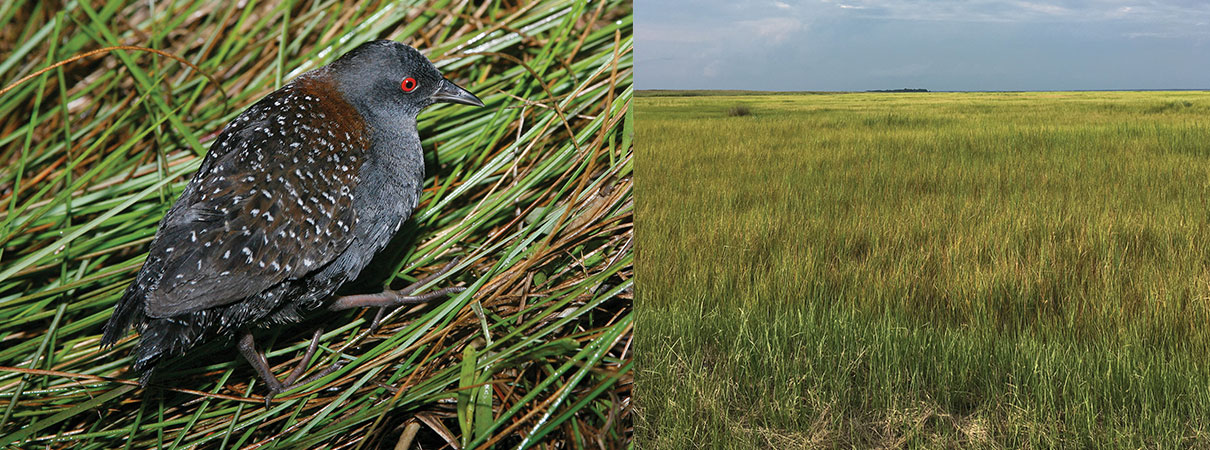
Left: Black Rail. Photo by Brian Small. Right: Brackish marsh at Elliott Island, Maryland. Photo by Howard Youth.
The Atlantic Coast is one of the most populous regions in the United States and hosts some of the most important wetlands, which are threatened by sea level rise and urbanization. The primary focus of the Atlantic Coast JV is restoring and protecting coastal marshes and species.
The Black Rail is one of these. This tiny, secretive marsh bird has declined by more than 90 percent along the Atlantic Coast since the 1990s. The Atlantic Coast JV's efforts to save the rail include two major mapping projects identifying ideal Black Rail habitat throughout the Southeast, and adaptive management and pilot projects aimed at quickly targeting and spearheading a rebound for this declining phantom of the wetlands.
This JV includes partners from across the full extent of U.S. Atlantic marshes, from Maine to Florida, and also includes Puerto Rico.
Appalachian Mountains: Managing Bountiful Forests
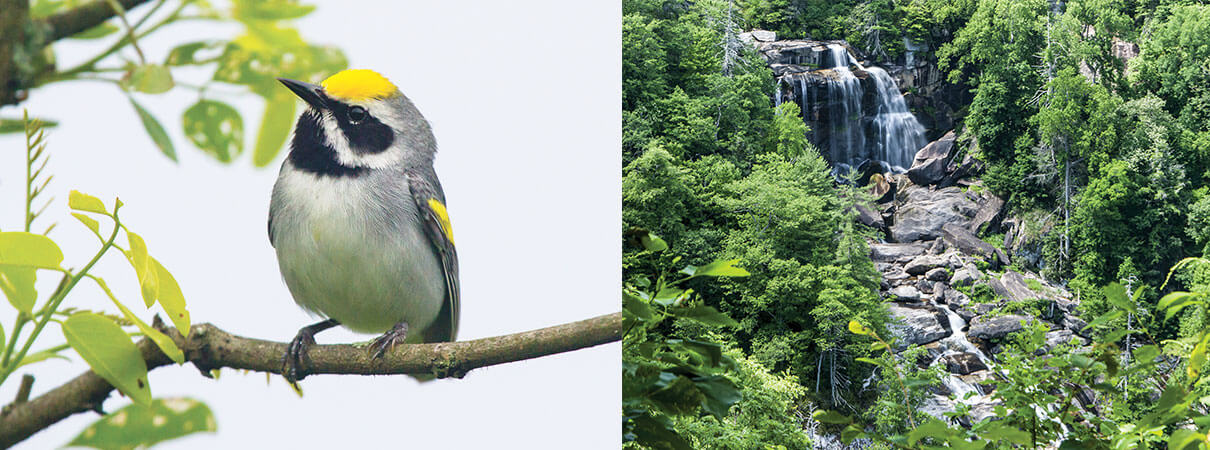
Left: Golden-winged Warbler. Photo by Frode Jacobsen/Shutterstock. Right: Waterfall in Great Smoky Mountains. Photo by Betty Shelton/Shutterstock.
Spanning the mountains from central New York to northeastern Alabama, the Appalachian Mountains JV works across a range of habitats and elevations, from old fields and small forested wetlands to oak-hickory forests and high-elevation spruce-fir stands, to help declining bird species.
Challenges to bird habitats in the region include lack of diverse forest structure, the loss of once-predominant tree species, deer over-browsing, invasive species, and energy development. Various strategies are employed, including active management, restoration, and protection of forests.
ABC is one of more than 55 partners working together to bring back and maintain native forests for the benefit of birds and other wildlife in the Appalachians.
Central Hardwoods: Midland Mosaic
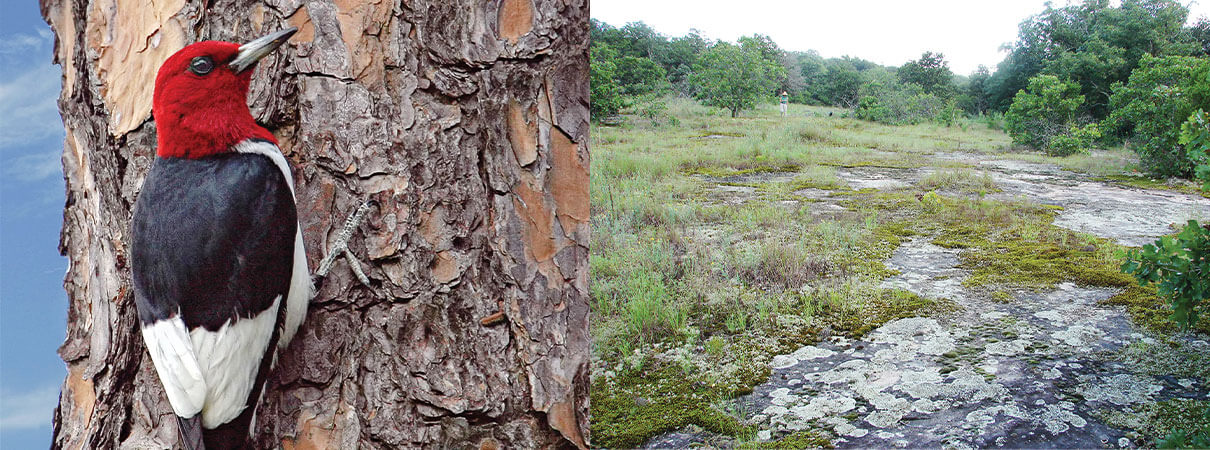
Left: Red-headed Woodpecker. Photo by Ronnie Howard/Shutterstock. Right: Sand glade. Photo by Missouri Department of Conservation.
In this JV, 11 partner agencies and organizations work together to manage bird habitat and ensure the long-term survival of native bird populations, both west and east of the Mississippi River. From Indiana to Oklahoma, the Central Hardwoods JV spans eight states rich in varied habitats, including forests, open pine and oak woodlands with grass and shrubby understories, open grasslands, and wetlands.
More than 193,000 acres of habitat were improved in 2018 alone. This habitat restoration included prescribed fire and tree-thinning in woodlands to promote the growth of shrubs, young trees, and forbs, and seeding nonnative grasslands with native species.
Lower Mississippi Valley: Birds on the Bayou
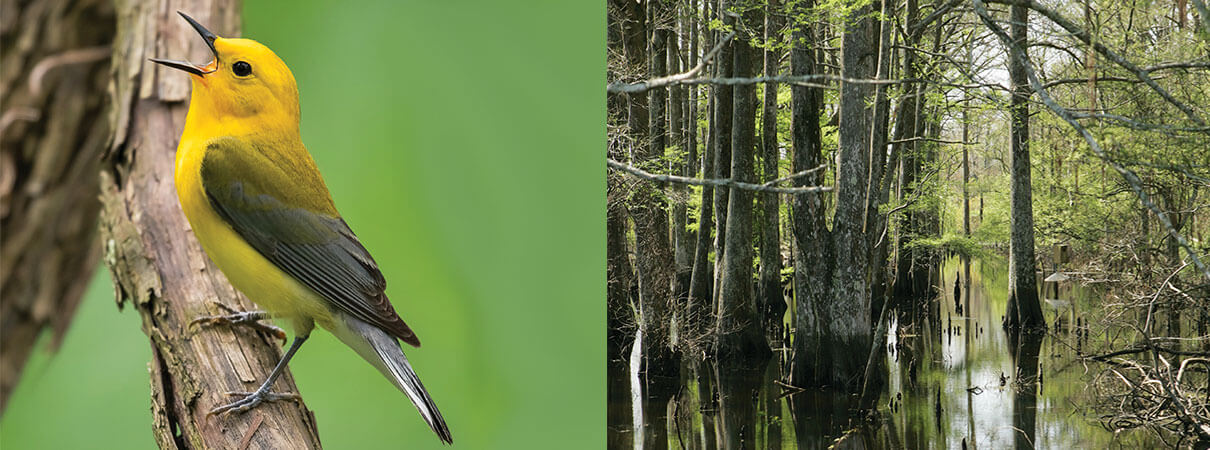
Left: Prothonotary Warbler. Photo by Jason Yoder. Right: Cypress swamp. Photo by FWS.
This JV includes dozens of partners and is guided by a management board representing 17 of them. It protects, restores, and manages habitats for declining birds in the Lower Mississippi Valley and West Gulf Coastal Plain/Ouachitas regions.
All told, 60 percent of North America's migratory birds breed or winter in, or migrate through, this region. It is, for example, the continent's most important wintering area for Mallards and Wood Ducks.
Species requiring large habitat tracts, such as the Swallow-tailed Kite, have benefited from this JV's efforts to work with partners on assessing, managing, and restoring core forest areas and wetlands throughout the region. After years of partnership, the Lower Mississippi River Delta has seen a net gain of 1 million acres of hardwood forest since 1992.
Oaks and Prairies: Getting a GRIP
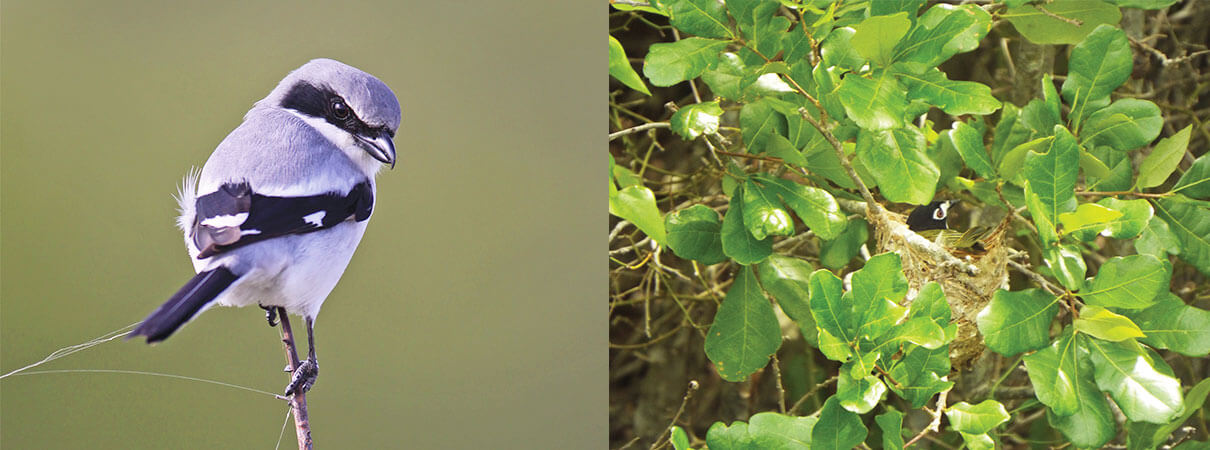
Left: Loggerhead Shrike. Photo by Wild Art/Shutterstock. Right: Black-capped Vireo on nest. Photo by Jim Giocomo.
Many declining grassland species call the Oaks and Prairies JV home. The partners of the Oaks and Prairies JV created and implement a Grassland Restoration Incentive Program (GRIP) to restore and maintain habitat for these species, providing incentive payments to private landowners who implement grassland bird habitat improvements to their land. Since 2013, more than 75,000 grassland acres in central Texas and more than 5,000 in central Oklahoma have been restored, much of it through prescribed fire, prescribed grazing, brush management, and replanting native grasses and forbs.
Two of North America's most localized songbirds, the Endangered Golden-cheeked Warbler and the Black-capped Vireo, nest within portions of the Oaks and Prairies JV, benefiting from the partners' management and restoration work.
Rio Grande: Wrangling Diverse Habitat
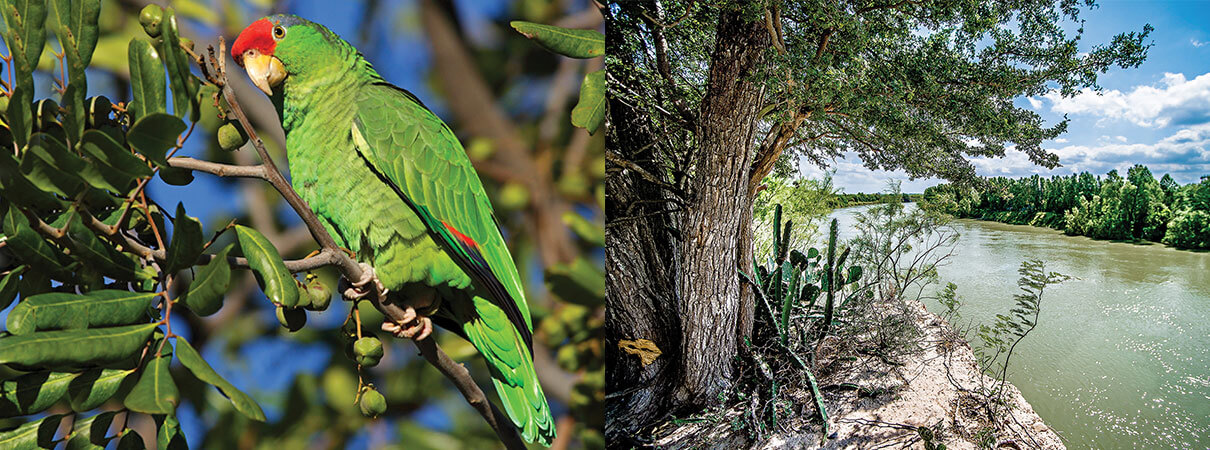
Left: Red-crowned Parrot. Photo by Bowles Erickson/Amazonia.us. Right: Rio Grande River. Photo by digidreamgrafix/Shutterstock.
Working in West and South Texas and northern Mexico, the Rio Grande JV brings together conservation partners to enhance habitat in one of the continent's most biologically diverse areas. The Rio Grande JV has projects in the Chihuahuan Desert, Tamaulipan Brushlands, and the Gulf Coast Prairie Bird Conservation Regions, where priorities include enhancing and conserving grasslands and riparian woodlands.
The partnership emphasizes working with landowners and stewards to help sustainably manage these habitats through various practices, including carefully planned livestock grazing, controlling invasive species, and planting native grasses, wildflowers, and trees so that birds, pollinators, and other wildlife can thrive.
California Central Coast: The "Last JV"
In 2020, ABC was involved in the launch of another JV, the California Central Coast JV (C3JV). It's the seventh where ABC hosts staff, but more significantly, the C3JV is the final piece of the JV "puzzle," providing JV coverage of the entire United States. The C3JV covers an incredibly biodiverse area, from old-growth redwood forests to rare dune ecosystems, spanning more than 7 million acres. The species the C3JV works to conserve are as diverse as their habitats and include the iconic California Condor, the beach-nesting California Least Tern, and the riparian-dwelling Least Bell's Vireo.
The creation of the C3JV represents a bittersweet accomplishment: One of ABC's most long-tenured staff members, David Pashley, was the driving force behind the JV concept and worked tirelessly to ensure that migratory bird habitat across the country could be more effectively conserved. Pashley passed away in 2018. The C3JV is dedicated to his memory.


















































